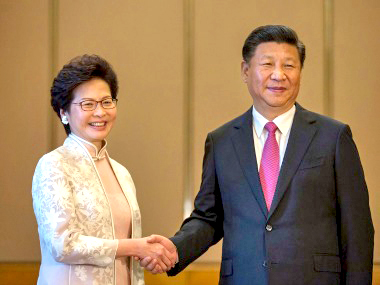Hong Kong, Jul 1: Carrie Lam, who was sworn in as Hong Kong's first female leader on Saturday, is a former student activist who climbed the rungs of the civil service over 36 years, and a tough, capable and possibly divisive Beijing-backed leader.
Lam, most recently Hong Kong's number two official, has to unify the Chinese-ruled city as public resentment swells at Beijing's growing interference in its affairs despite being promised a high degree of autonomy.
She also has to reinvigorate the economy and address growing social inequalities and high property prices, issues Chinese president Xi Jinping highlighted at her swearing-in ceremony.
Several sources who have worked with Lam say she's intelligent, hard-working and able to push controversial government policies, earning her the trust of Beijing factions who strongly lobbied for votes on her behalf when she was chosen in March.
But her hardline and pro-Beijing tendencies, say critics and opposition democrats, risk sowing further social divisions in the former British colony that returned to China 20 years ago under a "one country, two systems" formula that guarantees it wide-ranging freedoms.
"Carrie Lam ... is a nightmare for Hong Kong," said student activist Joshua Wong in March, one of the leaders of the student-led "Umbrella Movement" protests in 2014 which blocked the streets for 79 days demanding full democracy.
"Theoretically, the chief executive is a bridge between the central government and the Hong Kong people. But Lam will be a tilted bridge. She will only tell us what Beijing wants, and won't reflect what the people want to the communist regime."
Lam, dubbed "the fighter" by media, was once the most popular official in the cabinet of staunchly pro-Beijing former chief executive, Leung Chun-ying, who in 2012 won a similar election restricted to just 1,200 voters.
"Picking Carrie as chief secretary was Leung's best appointment," said a senior government official who declined to be identified because he was not authorised to speak to the media. But she could also sometimes be a "bully", he added.
Softer Image
Lam's popularity began to slip just as a younger generation of protesters rose to prominence, and tumbled further during the course of her election campaign this year.
Her attempt to push through a planned Palace Museum in Hong Kong, showing artefacts from the museum in Beijing's Forbidden City, was criticised for being presented as a done deal without public consultation, highlighting what some describe as her "autocratic" style, according to a source who knows her.
She is not well regarded by the opposition democratic camp, with most of the 300 or so democrats seen having voted for former Financial Secretary John Tsang.
The bespectacled Lam was also criticised by student leaders for being "vague" after their televised meeting failed to defuse the 2014 protests. The demonstration ran out of steam two months later and ended with police clearing the streets.
During her campaign, Lam attempted to present a softer, more populist image, but was ridiculed for gaffes including not appearing to know how to use subway turnstiles.
She was also lampooned for a late-night hunt for toilet paper which took her to her posh former home on the Peak after she failed to find any at a convenience store.
The daughter of a Shanghainese immigrant who worked on ships and a mother who had never received a formal education, Lam grew up in a cramped apartment shared by four siblings and several families.
A devout Catholic and a student of sociology at the University of Hong Kong, Lam took part in social activism before joining the government. She is married with two sons.
Lam joins a select group of female leaders who have risen to the top job in Asia in recent years including Taiwan President Tsai Ing-wen, hugely distrusted by China, and ousted South Korean president Park Geun-hye, who angered Beijing with her plans to deploy a United States missile defence system to counter the threat from North Korea.





Comments
Add new comment